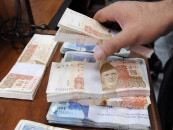Fiscal irresponsibility: Spendthrift govt digs a massive hole for the economy
Fiscal Responsibility and Debt Limitation Act violated for fifth year in a row.

The delay in reforms, particularly in energy and taxation, has led to fiscal slippages that have eventually piled up more debts. DESIGN: KIRAN SHAHID
Displaying deep-rooted fiscal indiscipline, the federal government has violated the Fiscal Responsibility and Debt Limitation (FRDL) Act for the fifth year in a row, leaving critical economic reforms needed to turn the slowing economy around for the next political setup.
The Ministry of Finance has admitted the violation in a statement on fiscal and debt developments it is obligated to release. The report, which tracks developments over the last financial year (2011-12) and the first quarter of the current fiscal year, has been submitted to parliament.
Though the finance ministry tried its best to tone down the failures, the statement shows that the federal government repeatedly compromised the principles of sound fiscal and debt management as it refrained from undertaking much-needed economic reforms. The delay in reforms, particularly in energy and taxation, has led to fiscal slippages that have eventually piled up more debts.
Under the FRDL Act of 2005, the government will have to explain to parliament the reasons for compromising on principles. The statement has tried to place responsibility on international developments like the debt crisis in Europe, the fiscal cliff in the US and weak international demand.
Analysts believe that any new government will have a tough time taking necessary actions in its first days in order to put the economy back on track.

According to the Fiscal Policy Statement 2012-13, the revenue deficit has remained at 4.4% of GDP or Rs909 billion, which is in violation of the law. This is the fifth consecutive year the government has violated this clause of the act, which is meant to ensure fiscal discipline.
Similarly, clauses that call for restricting the debt-to-GDP ratio below 60% and reducing national debt by 2.5% over the debt level of the preceding year were also violated by wide margins. Instead of reducing debt by 2.5% over last year’s level of 59.3%, the government’s total public debt has increased to 61.3% by June last year, according to the statement.
In yet another violation, the government also could not double expenditures on health and education, which remain below the targeted level. The only condition that the government met is the issuance of new sovereign guarantees. As against a maximum limit of 2%, the government has issued new guarantees worth 1% of GDP.
During last fiscal year, the federal government added roughly Rs2 trillion to the debt stock – an alarming growth of 18.4% in a single year. “Increase in the outstanding stock of total debt has implications for the economy in the shape of greater amount of resource allocation towards servicing in future,” the ministry admits.
The government admitted that slippages in both revenues and expenditures have led to a historical budget deficit of 8.53% of GDP, or Rs1.761 trillion. According to the statement, revenues fell behind the target by Rs304 billion, while expenditures shot up by Rs215 billion – indicating an accumulative slippage of Rs519 billion.
Furthermore, the government missed all aspects of the Budget Strategy for 2011-12. The budget deficit could not be contained to 4% of GDP, and was instead recorded at a historic level of 8.53%. The Federal Board of Revenue’s tax target could not be achieved, tariff subsidies could not be eliminated, subsidies on food and fertiliser continued unabated and the ban on new jobs was violated for political compulsions.
The country’s primary balance – a measure of total revenues adjusted for non-interest expenditures – remained at 2.2% of GDP or Rs446 billion, indicating that the government is in a debt trap as it borrows increasingly to retire previous debts.
One of the reasons behind fiscal constraints, the ministry said, was that despite the devolution of 17 ministries, the federal government’s expenses did not fall as it only created more ministries and continued to finance interprovincial programmes, which brought the federation under extreme fiscal pressures.
Published in The Express Tribune, February 5th, 2013.
Like Business on Facebook to stay informed and join in the conversation.


















COMMENTS
Comments are moderated and generally will be posted if they are on-topic and not abusive.
For more information, please see our Comments FAQ